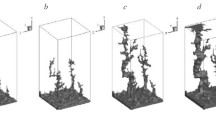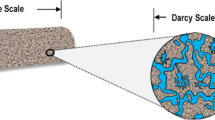Abstract
In carbonate reservoirs, acid is injected into the formation under breakdown pressure to react with the rock to remove the contaminations caused by drilling and production, which is called carbonate acidizing in reservoir development. In carbonate acidizing, acid flows selectively through large pores to create wormholes. Wormhole propagation under experimental condition has been studied by many experts. In this paper, a model which couples a two-scale continuum model simulating wormholing in the invaded zone and a reservoir flow model for the compressed zone was used to study the wormhole propagation behavior under reservoir condition. In this model, the porosity values which are uniformly distributed used in former literature follow the normal law. Based on the model, we first compared the results of the two porosity generation methods, and then studied the wormhole propagation behavior under reservoir condition, and finally simulated a two-layer formation to study the effects of distance and permeability ratio between the two layers. The results show that the normally distributed porosities simulate wormholing better. The effect of compressed zone on wormhole propagation increases with the decrease of compressibility factor and wormhole has a maximal value in length. The effect of distance between the two layers on wormhole lengths and acid distributions can be divided into three zones based on the wormhole length in the lower layer. A critical value of permeability ratio between the two layers exists, below and above which the wormhole length in the low permeability layer decreases sharply and almost keeps constant, respectively.
Similar content being viewed by others
Abbreviations
- a 0 :
-
Initial average interfacial area per unit volume of the medium (m−1)
- a v :
-
Interfacial area per unit volume of the medium (m−1)
- A v :
-
Dimensionless interfacial area
- C f :
-
Cup-mixing concentration of acid in the fluid phase (mol L−1)
- c f :
-
Dimensionless cup-mixing concentration of acid in the fluid phase
- C l :
-
Formation fluid compressibility factor (MPa−1)
- C 0 :
-
Initial concentration of acid (mol L−1)
- C s :
-
Concentration of acid at the solid–fluid interface (mol L−1)
- c s :
-
Dimensionless concentration of the acid at the fluid–solid interface
- c v :
-
Coefficient of variation
- Da :
-
Damköhler number, ratio of reaction rate to mass transfer rate
- D m :
-
Molecular diffusivity (m2 s−1)
- D eR :
-
Effective dispersion tensor in the radial direction (m2 s−1)
- D eθ :
-
Effective dispersion tensor in the circumferential direction (m2 s−1)
- D r :
-
Dimensionless effective dispersion coefficient in the radial direction
- D θ :
-
Dimensionless effective dispersion coefficient in the circumferential direction
- Ĝ:
-
Standard Gaussian/normal distribution function
- K :
-
Permeability of the medium (μm2)
- K 0 :
-
Initial average permeability of the medium (μm2)
- k :
-
Dimensionless permeability of the medium
- K 0h :
-
Initial average permeability in the high permeability layer (μm2)
- K 0l :
-
Initial average permeability in the low permeability layer (μm2)
- k c :
-
Mass transfer coefficient (m s−1)
- k s :
-
Surface reaction rate constant (m s−1)
- m :
-
Ratio of pore length to pore diameter
- N ac :
-
Acid capacity number, the volume of solid dissolved per unit volume of the acid
- p :
-
Dimensionless formation pressure
- P :
-
Reservoir pressure (MPa)
- P e :
-
Initial reservoir pressure (MPa)
- Pe :
-
Peclet number, ratio of diffusion time to convection time
- P r :
-
Reservoir pressure in the compressed zone (MPa)
- P I :
-
Pressure at the interface between the invaded zone and the compressed zone (MPa)
- P bh :
-
Inlet pressure (MPa)
- Re p :
-
Pore Reynolds number, ratio of inertial force to viscous force in the pore
- r w :
-
Wellbore radius (m)
- r invade :
-
Radius of the invaded zone (m)
- r e :
-
Radius of the compressed zone (m)
- r p :
-
Pore radius (m)
- r po :
-
Initial average pore radius (m)
- R(C s):
-
Reaction kinetics (m mol L−1 s−1)
- Sc :
-
Schmidt number, ratio of kinetic viscosity of the fluid to the molecular diffusivity
- Sh :
-
Sherwood Number, ratio of convective to diffusive mass transport
- Sh ∞ :
-
Asymptotic Sherwood number for the pore
- t′:
-
Time (s)
- t :
-
Dimensionless time
- u :
-
Dimensionless velocity in the radial direction
- |U|:
-
Magnitude of the Darcy velocity (m s−1)
- u 0 :
-
injection velocity (m s−1)
- u r :
-
Darcy velocity in the radial direction (m s−1)
- u θ :
-
Darcy velocity in the circumferential direction (m s−1)
- v :
-
Dimensionless velocity in the circumferential direction
- v s :
-
Kinetic viscosity of the fluid (m2 s−1)
- α :
-
Dissolving power of acid, defined as grams of solid dissolved per mole of acid reacted. (g/mol)
- α w :
-
Dimensionless wellbore radius
- α os, λr, λθ :
-
Numerical coefficients that depend on the structure of the medium
- β :
-
Exponent determined from experiment
- \({\varepsilon}\) :
-
Porosity of the medium
- \({\varepsilon_{0}}\) :
-
Initial average porosity of the medium
- ζ p :
-
Dimensionless pore radius
- η :
-
Dimensionless initial pore diameter
- μ :
-
Viscosity of the acid (mPa s)
- μ f :
-
Viscosity of the reservoir fluid (mPa s)
- ξ :
-
Dimensionless wormhole length in the radial direction
- ρ s :
-
Density of the rock (g cm−3)
- \({\phi^{2}}\) :
-
Pore scale Thiele modulus
- Φ2 :
-
Core scale Thiele modulus
References
Balakotaiah V., West D.H.: Shape normalization and analysis of the mass transfer controlled regime in catalytic monoliths. Chem. Eng. Sci. 57(8), 1269–1286 (2002)
Bazin B.: From matrix acidizing to acid fracturing: a laboratory evaluation of acid/rock interactions. SPE Prod. Facil. 16(1), 22–29 (2001)
Buijse M.A.: Understanding wormholing mechanisms can improve acid treatments in carbonate formations. SPE Prod. Facil. 15(3), 168–175 (2000)
Cohen C.E., Ding D., Quintard M., Bazin B.: From pore scale to wellbore scale: impact of geometry on wormhole growth in carbonate acidization. Chem. Eng. Sci. 63(12), 3088–3099 (2008)
Daccord G., Lenormand R., Lietard O.: Chemical dissolution of a porous medium by a reactive fluid-1. model for the “wormholing” phenomenon. Chem. Eng. Sci. 48(1), 169–178 (1993a)
Daccord G., Lenormand R., Lietard O.: Chemical dissolution of a porous medium by a reactive fluid-2. Convection vs reaction, behavior diagram. Chem. Eng. Sci. 48(1), 179–186 (1993b)
Chierici G.L.: Principles of Petroleum Reservoir Engineering, Vol. 1. Springer, Berlin (1994)
Fredd C.N., Fogler H.S.: Optimum conditions for wormhole formation in carbonate porous media: influence of transport and reaction. SPE J. 4(3), 196–205 (1999)
Frick, T.P., Mostofizadeh, B., Economides, M.J.: Analysis of radial core experiments for hydrochloric acid interaction with limestones. SPE27402. Presented at SPE International Symposium on Formation Damage Control, Lafayette, Louisiana, 7–10 February 1994
Gdanski, R.: A fundamentally new model of acid wormholing in carbonate. In: SPE European Formation Damage Conference, The Netherlands, 31 May–01 June 1999
Golfier F., Zarcone C., Bazin B., Lenormand R., Lasseux D., Quintard M.: On the ability of a Darcy-scale model to capture wormhole formation during the dissolution of a porous medium. J. Fliud Mech. 457, 213–254 (2002)
Greenkorn R.A.: Flow Phenomena in Porous Media: Fundamentals and Applications in Petroleum, Water, and Food Production. Marcel Dekker, New York (1983)
Hoefner M.L., Fogler H.S.: Pore evolution and channel formation during flow and reaction in porous media. AIChE J. 34(1), 45–54 (1988)
Hollis C., Vahrenkamp V., Tull S., Mookerjee A., Taberner C., Huang Y.: Pore system characterisation in heterogeneous carbonates: an alternative approach to widely-used rock-typing methodologies. Mar. Pet. Geol. 27(4), 772–793 (2010)
Huang, T., Hill, A.D., Schechter, R.: Reaction rate and fluid loss: the keys to wormhole initiation and propagation in carbonate acidizing. SPE37312. Presented at SPE International Symposium on Oilfield Chemistry, Houston, Texas, 18–21 February 1997
Huang, T., Zhu, D., Hill, A.D.: Prediction of Wormhole population density in carbonate matrix acidizing. SPE54723. Presented at SPE European Formation Damage Conference, Hague, 31 May–01 June 1999
Hung K.M., Hill A.D., Sepehrnoori K.: Mechanistic model of wormhole growth in carbonate matrix acidizing and acid fracturing. JPT 41(1), 59–66 (1989)
Izgec, O., Keys, R., Zhu, D., Hill, A.D.: An integrated theoretical and experimental study on the effects of multiscale heterogeneities in matrix acidizing of carbonates. SPE115143. Presented at SPE Annual Technical Conference and Exhibition, Denver, Colorado, USA, 21–24 September 2008
Izgec, O., Zhu, D., Hill, A.D.: Models and methods for understanding of early acid breakthrough observed in acid core-floods of vuggy carbonates. SPE122357. Presented at SPE European Formation Damage Conference, Scheveningen, The Netherlands, 27–29 May 2009
Kalia N., Balakotaiah V.: Modeling and analysis of wormhole formation in reactive dissolution of carbonate rocks. Chem. Eng. Sci. 62(4), 919–928 (2007)
Kalia N., Balakotaian V.: Effect of medium heterogeneities on reactive dissolution of carbonates. Chem. Eng. Sci. 64(2), 376–390 (2009)
Kang, Q.J., Zhang, D.X., Chen, S.Y., He, X.Y.: Lattice Boltzmann simulation of chemical dissolution in porous media. Phys. Rev. E. 65(3), 036318/1–036318/8 (2002)
Liu X., Ormond A., Bartko K., Li Y., Ortoleva P.: A geochemical reaction-transport simulator for matrix acidizing analysis and design. J. Pet. Sci. Eng. 17(1–2), 181–196 (1997)
Panga, M.K.R.: Multiscale transport and reaction: two case studies. Ph.D. dissertation, The University of Houston (2003)
Panga M.K.R., Ziauddin M., Balakotaiah V.: Two-scale continuum model for simulation of wormholes in carbonate acidization. AIChE J. 51(12), 3231–3248 (2005)
Schoenfelder W., Glaser H., Mitreiter I., Stallmach F.: Two-dimensional NMR relaxometry study of pore space characteristics of carbonate rocks from a Permian aquifer. J. Appl. Geophys. 65(1), 21–29 (2008)
Tardy, P.M.J., Lecerf, B., Chrisianti, Y.: An experimentally validated wormhole model for self-diverting and conventional acids in carbonate rocks under radial flow conditions. SPE107854. Presented at SPE European Formation Damage Conference, Scheveningen, The Netherlands, 30 May–01 June 2007
Author information
Authors and Affiliations
Corresponding author
Additional information
This paper is dedicated to my father Kaizhen Liu and my mother Xi Wang.
Rights and permissions
About this article
Cite this article
Liu, M., Zhang, S., Mou, J. et al. Wormhole Propagation Behavior Under Reservoir Condition in Carbonate Acidizing. Transp Porous Med 96, 203–220 (2013). https://doi.org/10.1007/s11242-012-0084-z
Received:
Accepted:
Published:
Issue Date:
DOI: https://doi.org/10.1007/s11242-012-0084-z




